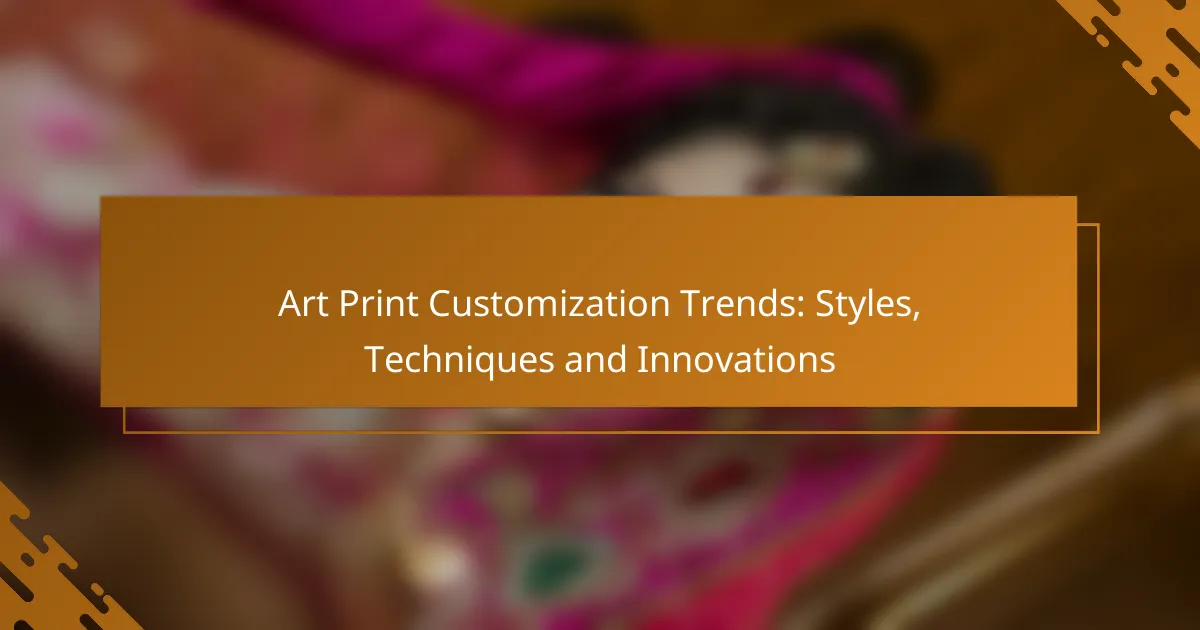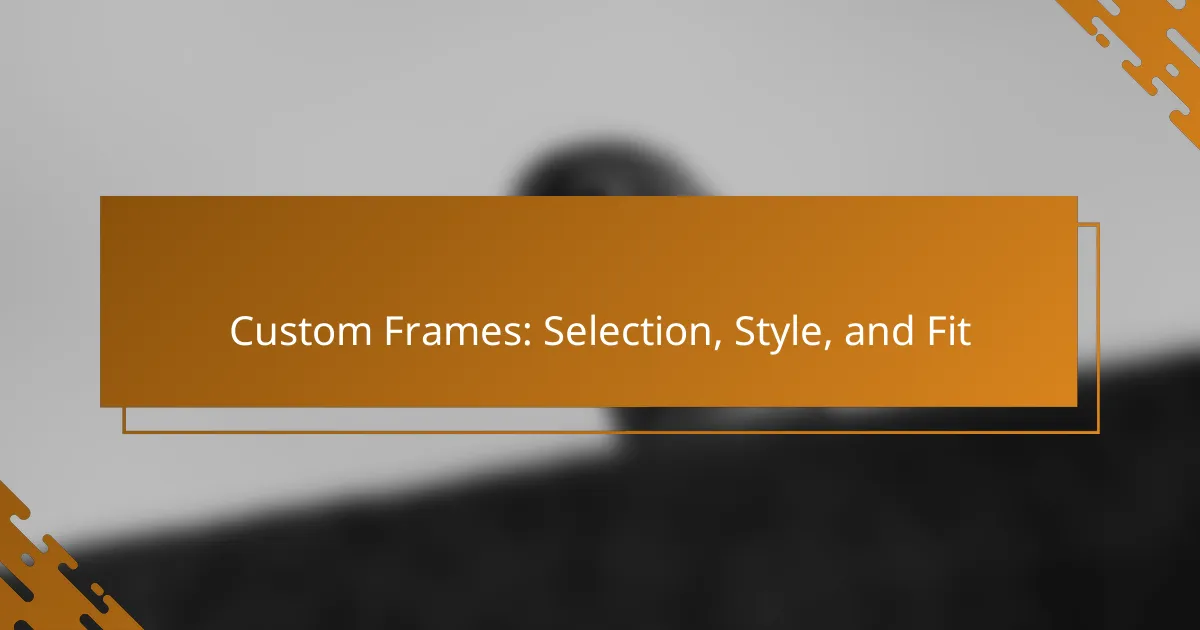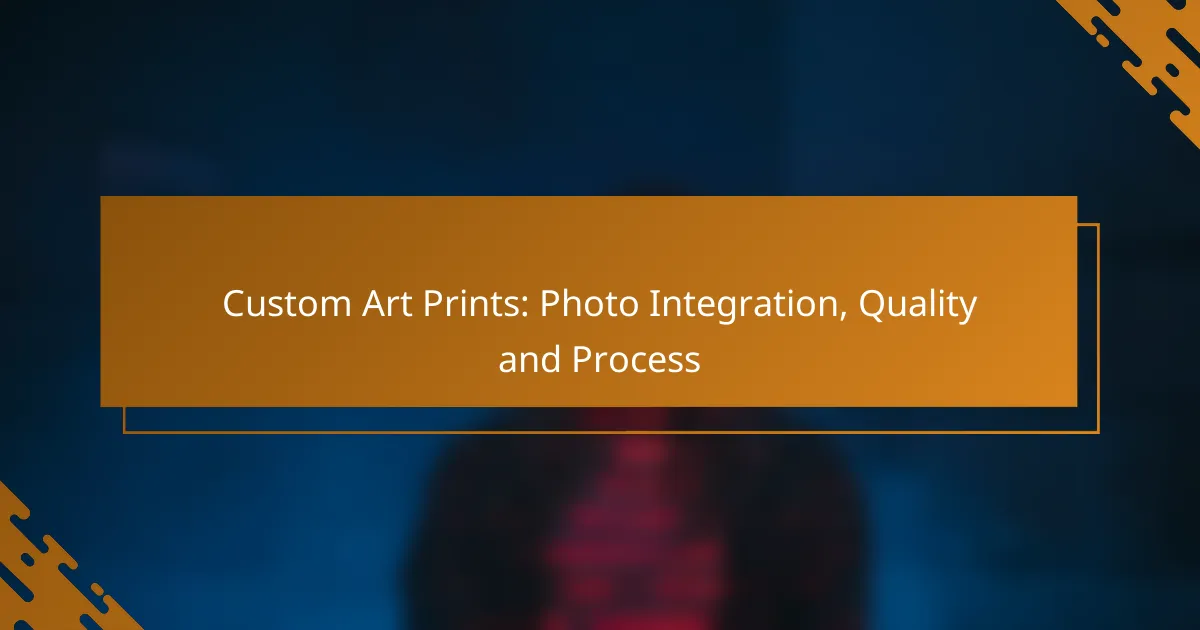The latest trends in art print customization emphasize personalization, sustainability, and innovative technology, catering to a growing demand for unique and eco-friendly designs. Artists and consumers are exploring various techniques, such as Giclée printing and mixed media, to create prints that resonate emotionally and stand out in the market. Understanding target audience preferences is crucial for selecting the right styles and techniques to enhance the value of art prints.
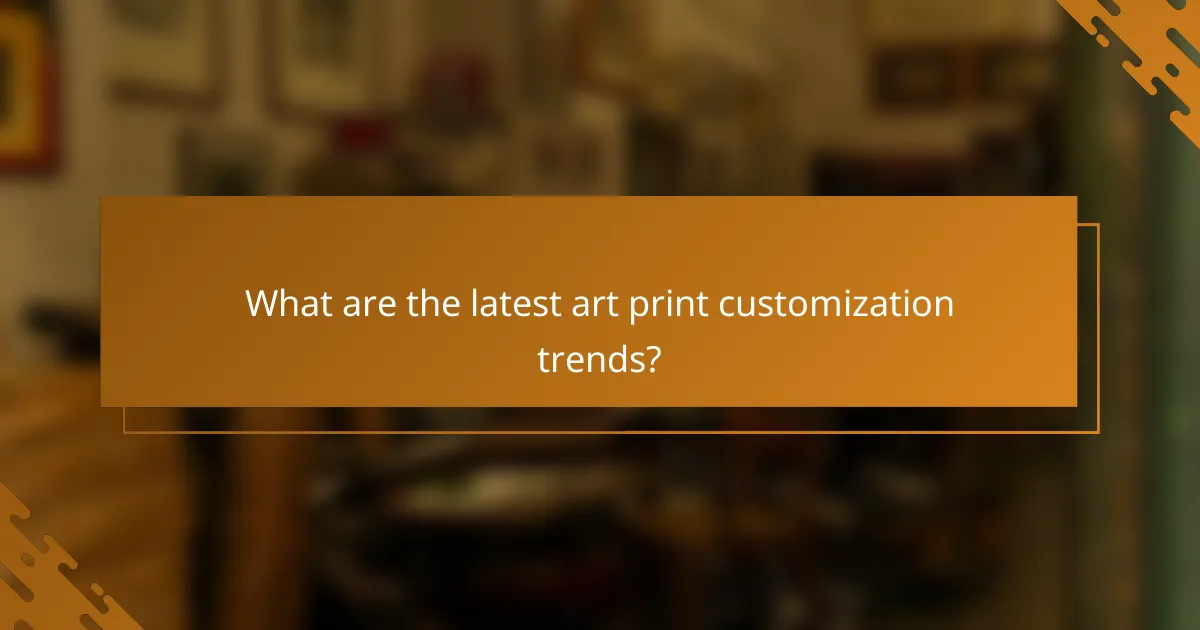
What are the latest art print customization trends?
The latest trends in art print customization focus on personalization, sustainability, and innovative technology. Artists and consumers are increasingly seeking unique designs, eco-friendly materials, and interactive experiences that enhance the value of art prints.
Personalized designs
Personalized designs allow customers to create art prints that reflect their individual tastes and preferences. This trend often includes custom color schemes, themes, and even incorporating personal photographs or messages into the artwork.
To successfully implement personalized designs, artists can offer online tools that let customers visualize their customizations in real-time. This interactive approach can significantly enhance customer satisfaction and engagement.
Eco-friendly materials
Eco-friendly materials are becoming a priority in the art print industry as consumers seek sustainable options. Artists are increasingly using recycled paper, organic inks, and biodegradable packaging to minimize environmental impact.
When choosing eco-friendly materials, consider certifications such as FSC (Forest Stewardship Council) for paper and low-VOC (volatile organic compounds) inks. These choices not only appeal to environmentally conscious buyers but can also enhance the overall quality and durability of the prints.
Augmented reality integration
Augmented reality (AR) integration is transforming how art prints are experienced. By using AR technology, customers can visualize how a print will look in their space through their smartphones or tablets before making a purchase.
To incorporate AR, artists can create apps or partner with existing platforms that support this technology. This innovation not only enhances the buying experience but also allows for interactive storytelling, making the artwork more engaging.
Limited edition releases
Limited edition releases create a sense of exclusivity and urgency among buyers. Artists often produce a small number of prints, which can increase their value and appeal to collectors.
When launching limited editions, it’s essential to clearly communicate the number of prints available and provide a certificate of authenticity. This practice can enhance the perceived value and attract serious art enthusiasts.
Collaborations with local artists
Collaborations with local artists are gaining traction as a way to support community creativity and diversify offerings. By partnering with local talent, established artists can create unique pieces that resonate with regional audiences.
To effectively collaborate, artists should consider joint exhibitions or co-branded prints that highlight both styles. This approach not only fosters community engagement but also expands the reach of both artists to new audiences.

How to choose the right customization style?
Selecting the right customization style for art prints involves understanding your target audience and their preferences. Consider factors such as current trends, the emotional impact of styles, and the uniqueness of techniques to ensure your offerings resonate with customers.
Understanding customer preferences
Customer preferences play a crucial role in determining the right customization style for art prints. Engaging with your audience through surveys or social media can provide insights into their favorite colors, themes, and styles. This direct feedback helps tailor your offerings to meet their expectations.
Additionally, analyzing past sales data can reveal which styles have been popular among your customers. For instance, if abstract designs have consistently sold well, it may be wise to focus on similar styles in your future collections.
Evaluating market trends
Staying updated on market trends is essential for selecting effective customization styles. Regularly review industry reports, attend art fairs, and follow influential artists to identify emerging styles and techniques. This proactive approach allows you to adapt your offerings to align with current consumer interests.
Consider the impact of seasonal trends as well. For example, during the holiday season, customers may prefer festive themes or colors, while spring might see a rise in floral designs. By aligning your customization styles with these trends, you can enhance your market appeal and drive sales.
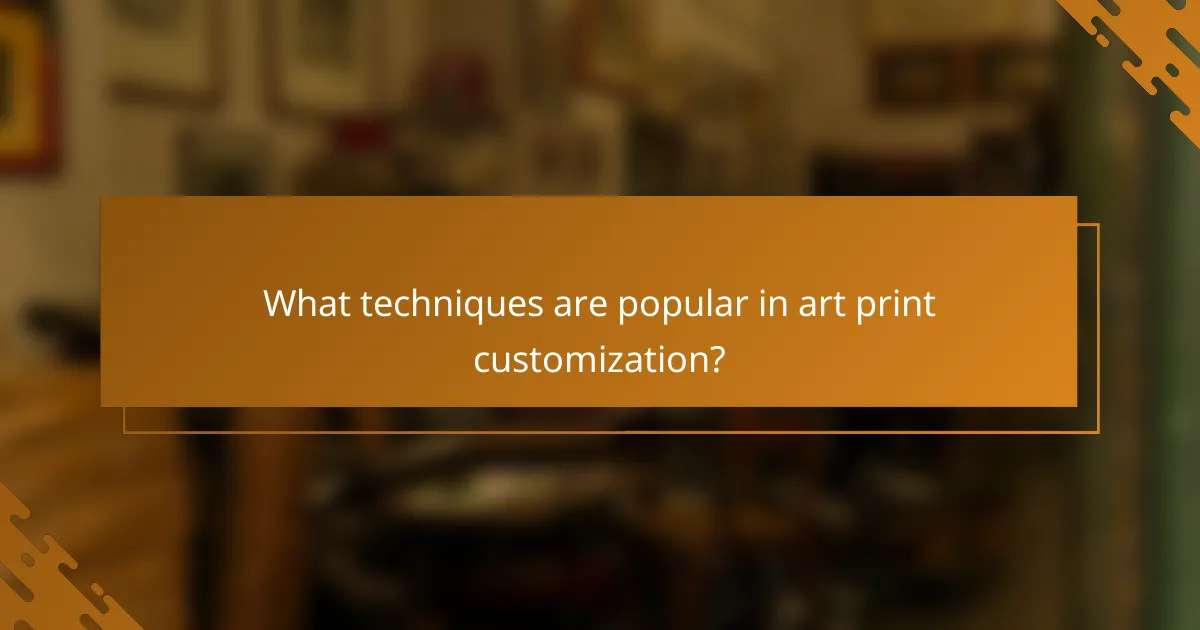
What techniques are popular in art print customization?
Popular techniques in art print customization include Giclée printing, screen printing, digital illustration, and mixed media approaches. Each method offers unique benefits and considerations for artists and consumers alike.
Giclée printing
Giclée printing is a high-quality inkjet printing method that produces vibrant and detailed reproductions of artwork. This technique uses archival inks and paper, ensuring longevity and color accuracy, making it a preferred choice for artists looking to sell limited editions.
When considering Giclée printing, artists should select high-resolution images and ensure their printers are calibrated correctly. The cost can vary, but expect to pay a premium for quality materials and printing services.
Screen printing
Screen printing involves pushing ink through a mesh screen onto the printing surface, allowing for bold colors and textures. This technique is ideal for creating multiple copies of a design, especially for textiles and posters.
Artists should consider the setup costs and the number of colors in their design, as each color requires a separate screen. Screen printing is often more economical for larger runs, making it a popular choice for merchandise.
Digital illustration
Digital illustration utilizes software to create artwork that can be printed directly or used in various formats. This technique allows for flexibility and quick iterations, making it suitable for artists who want to experiment with styles and concepts.
Artists should invest in good software and hardware to achieve high-quality results. Digital files can be easily modified, but it’s crucial to maintain high resolution for print quality.
Mixed media approaches
Mixed media approaches combine various techniques and materials, such as painting, collage, and digital elements, to create unique art prints. This method allows for creativity and personalization, appealing to a diverse audience.
When using mixed media, artists should consider how different materials interact and the final printing method. This technique can be more complex and may require additional time for experimentation and production.
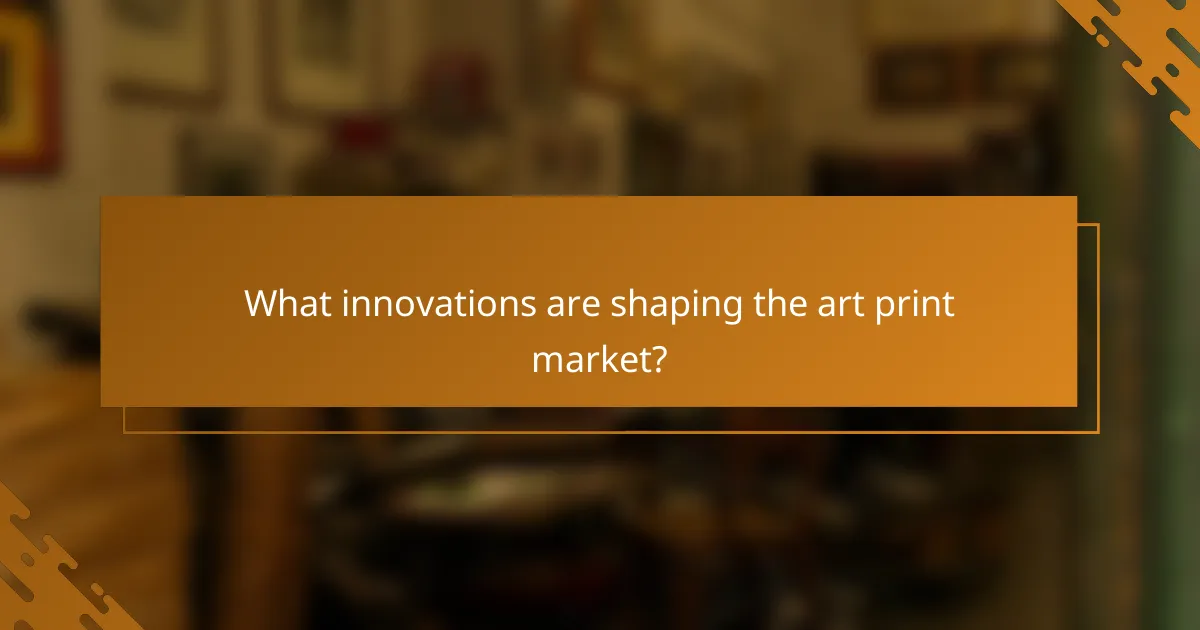
What innovations are shaping the art print market?
Innovations in the art print market are primarily driven by advancements in technology, enabling artists and consumers to create and access customized prints more easily. Key trends include the rise of 3D printing, AI-generated art, and on-demand printing services, each offering unique benefits and considerations.
3D printing technology
3D printing technology allows artists to create intricate, multi-dimensional art pieces that traditional printing cannot achieve. This method uses additive manufacturing to layer materials, resulting in unique textures and forms that can enhance the visual appeal of art prints.
When considering 3D printing for art, it’s essential to select the right materials, such as plastics or metals, depending on the desired finish. Artists should also be aware of the costs, which can vary widely based on complexity and material choice, often ranging from a few hundred to several thousand dollars.
AI-generated art
AI-generated art leverages algorithms to create unique pieces based on input parameters, enabling artists to explore new styles and concepts. This technology can produce art quickly and at a lower cost, making it accessible to a broader audience.
However, artists should consider the implications of originality and copyright when using AI tools. While AI can generate impressive works, the artist’s vision and intent remain crucial in guiding the final output, ensuring a balance between technology and creativity.
On-demand printing services
On-demand printing services allow artists to produce prints only when there is a customer order, reducing waste and inventory costs. This model is particularly beneficial for independent artists and small businesses, as it enables them to offer a wider range of products without significant upfront investment.
When using on-demand services, artists should evaluate the quality of print materials and the range of customization options available. It’s advisable to conduct a few test prints to ensure that the final product meets expectations, as quality can vary between providers. Pricing typically depends on factors like size, material, and print resolution, so artists should compare options to find the best fit for their needs.
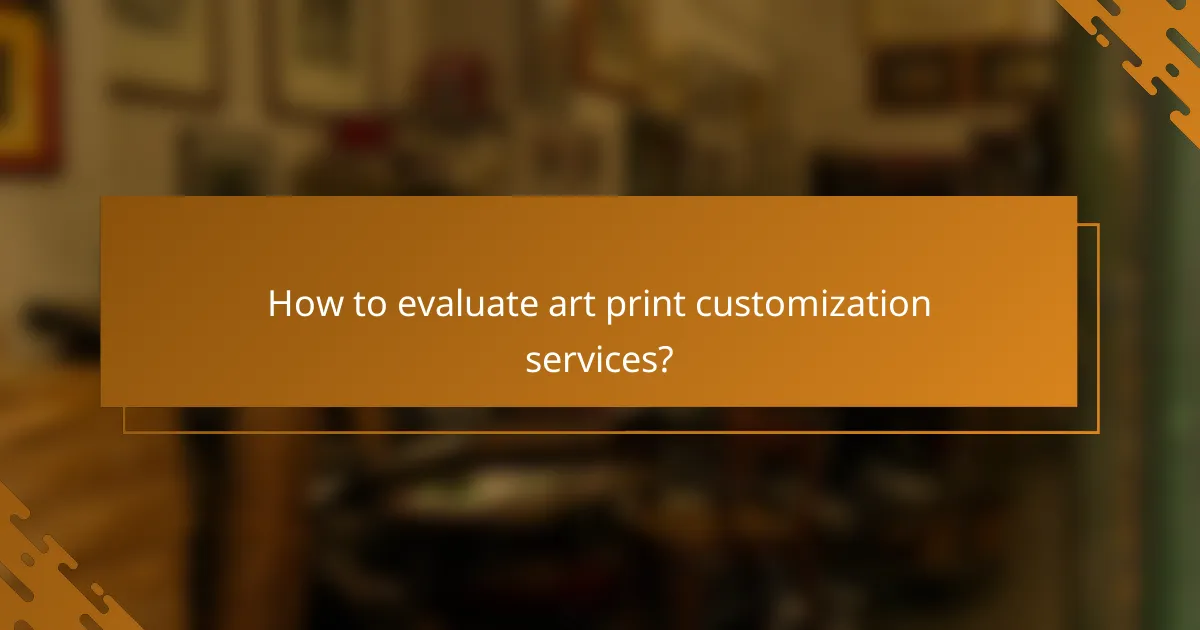
How to evaluate art print customization services?
To evaluate art print customization services, consider the quality of materials used, customer reviews and ratings, and their return and shipping policies. These factors will help you determine the reliability and value of the service you choose.
Quality of materials
The quality of materials is crucial in art print customization as it directly affects the final product’s durability and appearance. Look for services that use archival-quality paper and fade-resistant inks to ensure longevity. Common options include fine art paper, canvas, and photo paper, each offering different textures and finishes.
When assessing material quality, request samples if possible. This allows you to evaluate the texture, weight, and color fidelity of the prints before making a decision. A reputable service will often provide detailed descriptions of their materials and any certifications they may have.
Customer reviews and ratings
Customer reviews and ratings provide insight into the experiences of others with the art print customization service. Look for platforms that aggregate reviews, such as Trustpilot or Google Reviews, to get a balanced view of customer satisfaction. Aim for services with consistently high ratings and positive feedback regarding print quality and customer service.
Pay attention to specific comments about turnaround times and the responsiveness of customer support. A service that addresses concerns promptly and resolves issues effectively is often a reliable choice.
Return and shipping policies
Understanding the return and shipping policies of an art print customization service is essential to avoid potential issues. Check if they offer a satisfaction guarantee or a clear return policy for unsatisfactory products. This can save you from financial loss if the final print does not meet your expectations.
Additionally, consider shipping options and costs. Some services may offer free shipping over a certain order amount, while others might charge based on location or delivery speed. Knowing these details upfront can help you budget effectively and avoid surprises during checkout.

What are the pricing strategies for customized art prints?
Pricing strategies for customized art prints often involve a mix of cost-based, value-based, and competitive pricing. These strategies take into account the cost of materials, labor, and the perceived value of the artwork to the customer.
Cost of materials
The cost of materials is a significant factor in determining the price of customized art prints. This includes the type of paper, ink, and any additional elements like frames or protective coatings. For instance, high-quality archival paper may cost more but can enhance the print’s longevity and appeal.
When calculating material costs, consider sourcing options. Bulk purchasing can reduce expenses, while local suppliers might offer unique materials that justify a higher price point. Always balance quality with affordability to meet customer expectations.
Additionally, keep in mind that prices for materials can vary by region. In the U.S., for example, premium art paper can range from $1 to $5 per sheet, while specialty inks may add another $0.50 to $2 per print.
